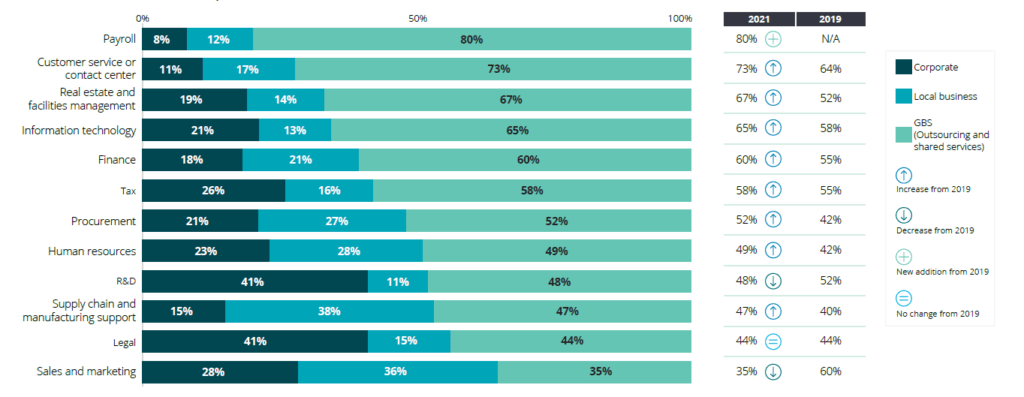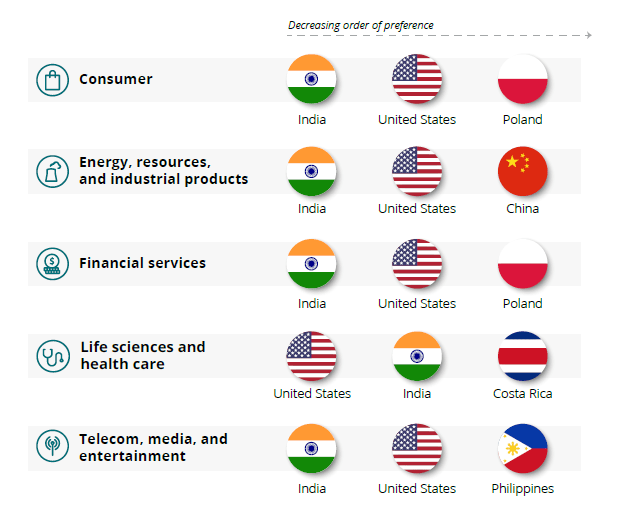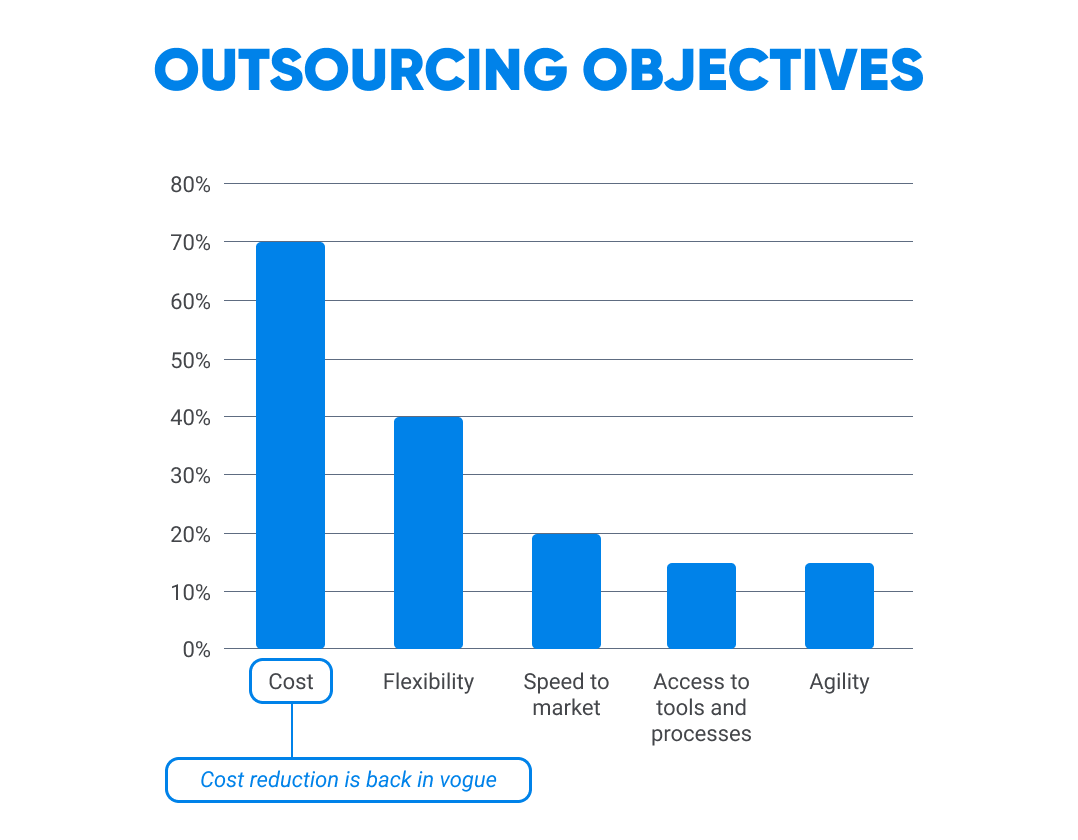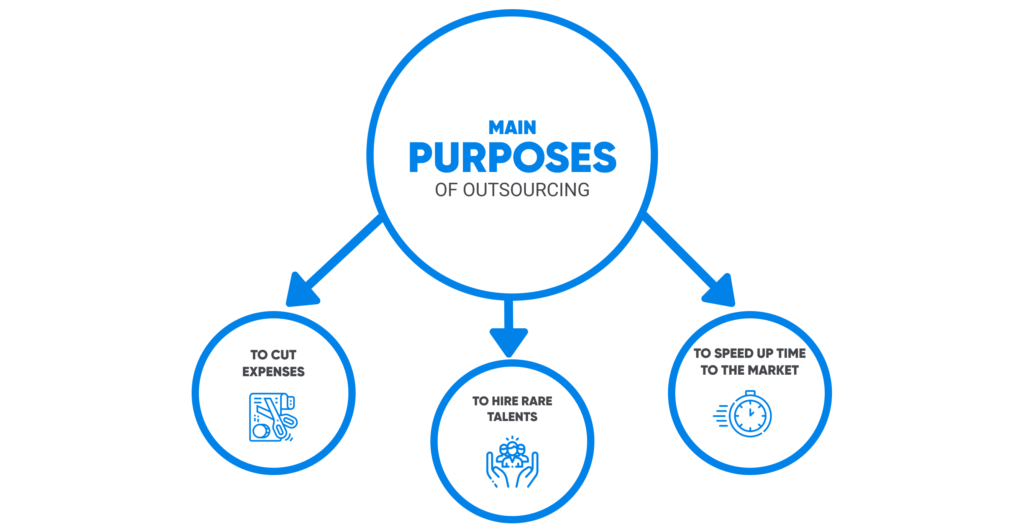The lack of highly skilled specialists necessary for the fastly developing IT sector is one of the main reasons why more and more companies choose outsourced IT support services and software development.
Just think of it – in eight years, businesses will need but wouldn’t be able to get almost 85 million technical specialists. This lack of labor force, predicted by Korn Ferry, would lead to a huge loss of annual revenue (up to $8.5 trillion). Looks like it’s high time to get better acquainted with the concept of delegating IT services, including software development, to third parties.
Contents:
- What is an example of outsourcing?
- What is the main purpose of outsourcing?
- When should you not outsource?
- Can companies outsource their IT process?
WHAT IS AN EXAMPLE OF OUTSOURCING?
Outsourcing is widely used in many businesses, from car manufacturing to software development. You can see what business processes are usually delegated to third parties in the image below.

Here are just some of the companies that choose to outsource part of their business processes:
- Zara and H&M used to build hundreds of factories in Bangladesh for outsourcing sewing and tailoring.
- General Motors has chosen nearshore outsourcing and operates four large manufacturing plants in Mexico.
- Hewlett-Packard chooses the Philippines for outsourcing customer and IT support services.
- Alibaba outsources software development to the USA.
- Facebook outsources content moderation and customer support to various regions of the planet.
- Toyota has factories in Poland and Thailand where it manufactures some of its car parts.
- Chanel outsources sunglasses manufacturing to Italy.
- Microsoft started outsourcing software development to India in 2004
- Samsung runs an R&D center in Kyiv, Ukraine.
- Apple outsources production to China and Taiwan
Along with that, most online shops outsource the development of their e-commerce websites; healthcare providers delegate medical coding and billing to third parties; and almost all banking groups, that want to stay in tune with the times, order financial apps from FinTech outsourcing companies.
One of the most frequent examples of outsourcing in IT is customer support outsourcing. Usually, a company based in a country with a high cost of living hires a company in a country with a lower cost of living. The contractor company then provides the client company with necessary services connected with supporting the IT product.
Good examples are Google which has representative offices with support teams in almost 60 countries and Microsoft which also delegates the functions of its call centers to third parties around the globe.
Software development is yet another business process that is frequently delegated to third parties. As a matter of fact, according to the Deloitte survey 2021, almost 65% of their respondents choose to outsource intellectual technologies instead of holding a large team of in-house developers and engineers.
Companies can choose between three main outsourcing models
- Full outsourcing aka fixed price outsourcing is a business model which presumes that a customer provides its vendor with full instructions, deadlines, and budget for the project they need and doesn’t have to interfere with the development process anymore.
- Classic outsourcing aka hiring a dedicated team means that a customer has an in-house team of developers but wants to ease their workload by delegating part of the tasks or some projects to third parties. In this case, a customer maintains controlling, managing, and planning functions during the development.
- Outstaffing aka staff augmentation is another way in which a customer can reinforce its in-house team with remote employees. By choosing outstaffing, a customer gets access to the expertise and hands-on experience of highly skilled technical specialists.
Outsourcing is also divided into variations depending on the geographical location of the customer and its vendor.
According to the geographical classification, there are three types of outsourcing
Offshoring means that you choose a vendor that is located in another region of the world. For example, you’re an Israeli company that works with a Ukrainian IT partner.
Nearshoring is when you hire a vendor that has its office in a country that has common borders with the country where your business is located. The case would be if a German customer hires an IT vendor from Poland.
Onshoring is a way to delegate software development services to a vendor that is located in the same country as your business. For example, a Congo-based branch of Vodafone getting help from a Congo-based IT company would be considered onshoring.
Overall, India continues to hold a leading position among all the industries that choose to outsource some of their business processes.
Here is a quick glance on top-3 countries for outsourcing composed by Deloitte:

WHAT IS THE MAIN PURPOSE OF OUTSOURCING?
Although its position throughout the years is changing, cost reduction always remains among the top 3 reasons, why companies choose to outsource. Among many others is the scalability of the business, better-organized working processes, flexibility, agility, access to the most innovative tools, and the best-skilled technical talents.
Here are the top 5 outsourcing objectives for 2020:

Image source: Deloitte Global Outsourcing Survey 2020
Here is a result of the MWDN survey – three main reasons for outsourcing declared by our customers:

Our customers opt for outsourcing to meet three main goals.
- To cut expenses.
Our American and Israeli clients note that the salaries of Ukrainian developers are much lower than the salaries of US or Israel-based developers with the same skill sets. By delegating some parts of their business to our country, they can drastically decrease their direct expenditures on labor costs.
- To hire rare talents.
A decade ago, businesses used to outsource tasks that required a labor force of low qualification, like assembly lines or call centers. This is not the case in 2022. Today companies opt for outsourcing to hire rare and unique talents that their native labor markets are lacking. Ukrainian developers, particularly those, hired by the MWDN are of Middle to Senior level and have years of hands-on experience with vintage and the newest technologies alike. For this reason, they are in high demand among our customers from Western Europe, the USA, and Canada. What is more, recently we started to hire tech talents all around the globe, which increases our talent pool even more and gives our customers access to even more varied specialists.
- To speed up the time to the market.
Our customers state that cooperation with our experts allows them to save time on the development and deployment of their projects. With our assistance, our clients can hire more remote specialists to work on their projects and by getting more experts to work on their tasks simultaneously, they can speed up the time their projects need to get to the market.
WHEN SHOULD YOU NOT OUTSOURCE?
Many companies choose to outsource their side projects while keeping full control over core businesses. Others believe that management and planning are not the things to be delegated to contractors from other countries. However, there are no strict rules about whether you should or shouldn’t choose to outsource any parts of your business.
Here are some examples when a particular outsourcing model is not the best choice for your particular case.
Don’t choose fixed price outsourcing if:
- You don’t have a comprehensive understanding of what you want to get as a final result.
- You want to control and manage the development process at every step.
- You want to be able to make amendments to your primary instructions.
- You have a tight budget. The thing is, fixed-price outsourcing is, as a rule, the most expensive outsourcing model.
Don’t choose classic outsourcing if:
- You don’t want to participate in the development process.
- You don’t need reports and meetings with the manager of your project.
- You have a tight budget, as classic outsourcing is not the cheapest way to delegate IT services to third parties either.
Don’t choose outstaffing if:
- You don’t have an in-house team of developers that you would like to reinforce.
In all the other cases, find your model of outsourcing and enjoy its multiple benefits.
CAN COMPANIES OUTSOURCE THEIR IT PROCESS?
If you have an office with hundreds of employees all working with computers, you will have to manage at least a small department of computer hardware specialists who would assist your workers with desktop setup and repairs when needed.
For the rest of the IT functions, including
- Support,
- Helpdesk,
- Software development,
- Software testing,
- DevOps,
- Work with databases,
- Business analysis,
- Processes automatization,
- Cybersecurity,
- Natural language processing,
- Artificial intelligence,
- Blockchain technologies,
- Robotics and engineering,
- Research and development, etc.
You can easily apply the outsourcing business model by hiring a reliable contractor.
Summing up
- Outsourcing is a major trend that you should embrace to keep up with the times and the changing market.
- The major benefit of outsourcing is that it allows you to cut expenditures and find the best solutions for your needs.
- There are thousands of successful examples of outsourcing IT services. Everybody does that, starting from Google and up to the smallest startups with limited budgets.
READ MORE ABOUT OUTSOURCING IN IT DEVELOPMENT AND SUPPORT :
- FIVE TYPES OF IT OUTSOURCING
- WHAT ARE THE BENEFITS OF OUTSOURCING IT SUPPORT?
- WHY TO OUTSOURCE? FAQ ON OUTSOURCING IN IT
Content
- 1 WHAT IS AN EXAMPLE OF OUTSOURCING?
- 2 WHAT IS THE MAIN PURPOSE OF OUTSOURCING?
- 3 WHEN SHOULD YOU NOT OUTSOURCE?
- 4 CAN COMPANIES OUTSOURCE THEIR IT PROCESS?
- 5 Summing up
